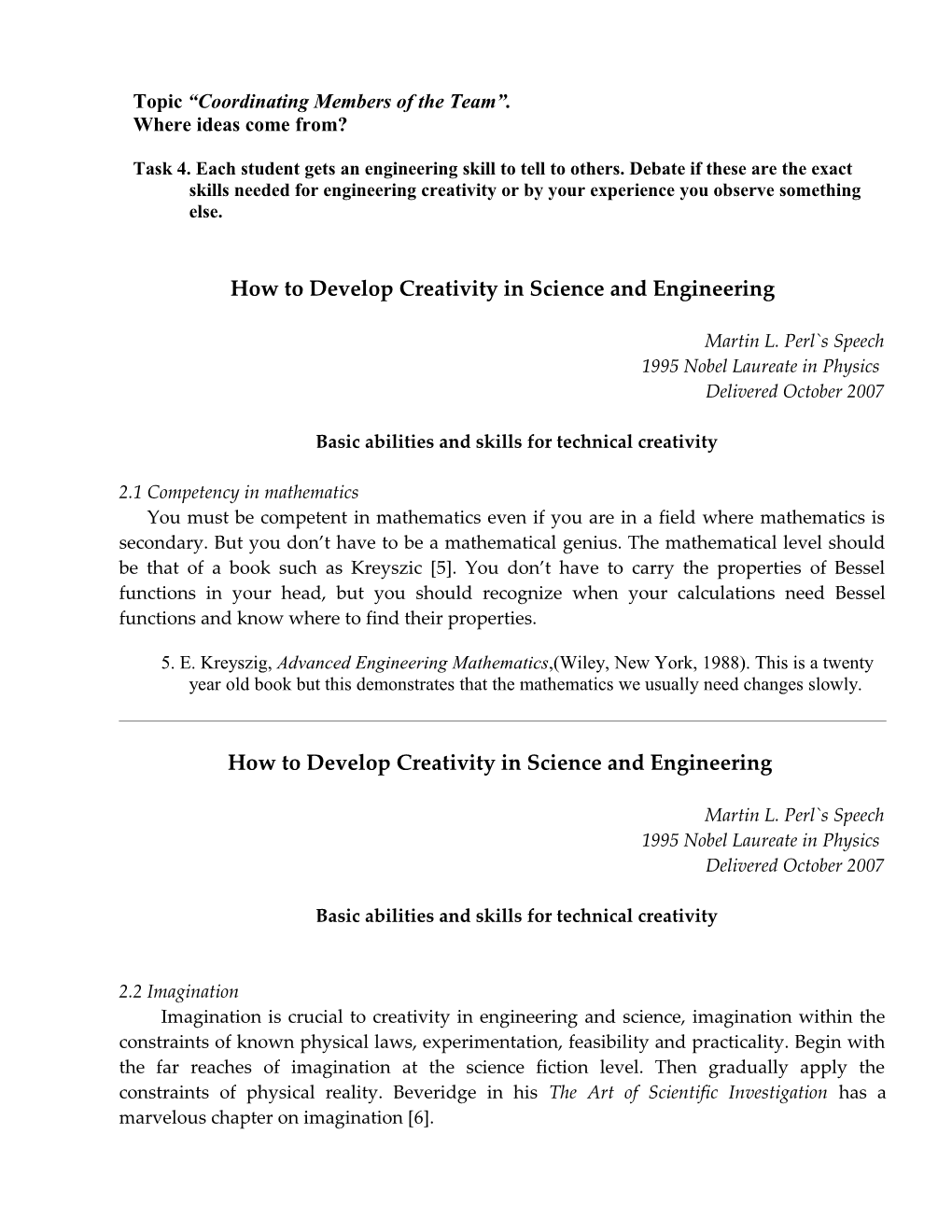Topic “Coordinating Members of the Team”.
Where ideas come from?
Task 4. Each student gets an engineering skill to tell to others. Debate if these are the exact skills needed for engineering creativity or by your experience you observe something else.
How to Develop Creativity in Science and Engineering
Martin L. Perl`s Speech
1995 Nobel Laureate in Physics
Delivered October 2007
Basic abilities and skills for technical creativity
2.1 Competency in mathematics
You must be competent in mathematics even if you are in a field where mathematics is secondary. But you don’t have to be a mathematical genius. The mathematical level should be that of a book such as Kreyszic [5]. You don’t have to carry the properties of Bessel functions in your head, but you should recognize when your calculations need Bessel functions and know where to find their properties.
5. E. Kreyszig, Advanced Engineering Mathematics,(Wiley, New York, 1988). This is a twenty year old book but this demonstrates that the mathematics we usually need changes slowly.
How to Develop Creativity in Science and Engineering
Martin L. Perl`s Speech
1995 Nobel Laureate in Physics
Delivered October 2007
Basic abilities and skills for technical creativity
2.2 Imagination
Imagination is crucial to creativity in engineering and science, imagination within the constraints of known physical laws, experimentation, feasibility and practicality. Begin with the far reaches of imagination at the science fiction level. Then gradually apply the constraints of physical reality. Beveridge in his The Art of Scientific Investigation has a marvelous chapter on imagination [6].
6. W. I. B. Beveridge, The Art of Scientific Investigation,(William Heinemann, London, 1953).
How to Develop Creativity in Science and Engineering
Martin L. Perl`s Speech
1995 Nobel Laureate in Physics
Delivered October 2007
Basic abilities and skills for technical creativity
2.3 Visualization
In engineering and scientific work it is crucial to be able to visualize how the work can be accomplished [7]. The intended work might be the invention of a mechanical or electronic device, the synthesis of a complicated molecule, the design of an experiment to evaluate the efficacy of a new drug, or the modeling of how proteins fold and unfold. There are many ways to visualize the development of your idea.
I draw pictures and do rough calculations in my notebooks. Some primarily use a computer. Others make models. Still, others just carry out the visualization in their heads until most of the details have been worked out. If you are working with others, intermediate technical notes and meetings are necessary. If I am thinking in the wrong direction I prefer to know sooner rather than later.
7. E. S. Ferguson, Engineering and the Mind’s Eye, (The MIT Press, Cambridge,1993).
How to Develop Creativity in Science and Engineering
Martin L. Perl`s Speech
1995 Nobel Laureate in Physics
Delivered October 2007
Basic abilities and skills for technical creativity
2.4 Hands-on and laboratory skills
When choosing what you work on in engineering and science, honestly evaluate the extent of your hands-on and laboratory skills. Are you good with tools, with repairing equipment, or perhaps with using a microscope? You cannot be creative if your daily work involves activities that weaken your confidence and self esteem. You can still do design work or theoretical work. Or, if you want to participate in the hands-on world, find a partner or a group with which to work.
My Ph. D. thesis advisor, Isidore Rabi, was given the Nobel Prize for his experimental work, but he had few hands-on skills. His graduate students were afraid to let him get close to their apparatus. When he came to the laboratory we immediately engaged him in conversation at the door, hoping he would get bored and leave. In spite of his hands-on limitations, he had a deep, mysterious way of understanding and visualizing experimental work.
How to Develop Creativity in Science and Engineering
Martin L. Perl`s Speech
1995 Nobel Laureate in Physics
Delivered October 2007
Basic abilities and skills for technical creativity
2.5 Computers
Computers have changed the world of the engineer and scientist. Learn to use a packaged general computing program such as Maple, Mathematica or MATLAB. I use Maple because my friend Marvin Weinstein is a Maple expert and I can always go to him with problems. I find the best way to make progress in computing is to have an expert as a resource.
The Internet is a great time saver for looking up references and reading papers. It is also great for looking up facts such as the properties of Bessel functions, but don’t try to learn Bessel functions from the Internet - for that you need a textbook.
